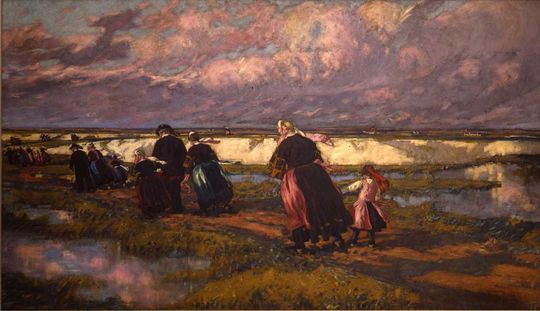Artwork for the Hotel de l’Epée
1905-1909

Oil on canvas
75-38
Acquired at a private sale in 1975
Decoration divided into 23 paintings
Jean-Julien Lemordant (1878-1968) was born in Saint-Malo and first visited the Bigouden region in 1901. He settled on the Penmarc’h headland close to the sea. In 1905, he was asked by the owners of the Hotel de l’Épée in Quimper, the best-known establishment in Cornouaille, to decorate the two adjoining dining rooms. The project was large and complex. He painted a continuous piece of work on canvas from the top of the wall seats to the ceiling, incorporating the ten doors leading to the lobby, the salons, the services and the kitchen. This decoration, more than <st1:metricconverter productid="65 mᄇ" w:st="on">65 m²</st1:metricconverter> in size, was divided into 23 paintings, broken down into sequences with a Bigouden theme. These paintings were presented at the autumn Fair in Paris and at the regional Fair in Rennes in 1907 and 1908. The work was exceptionally well received in Paris and Brittany and the best known critics of the time were enthusiastic about this young painter who had succeeded in incorporating modernity without abandoning traditional themes. Lemordant expresses, in a lyrical manner, the omnipresence of, and the struggle of man against nature, and bears witness to the power of Breton culture. The decoration was completed in 1908-1909 with two large canvases arranged in a half-arch representing the Eckmühl lighthouse and the Chapelle Notre-Dame-de-la-Joie.
By now, Lemordant was famous. He was commissioned to decorate the ceiling of the theatre in Rennes. The war brutally interrupted his promising career. Gravely wounded, he concentrated on other activities, but his work at Quimper remained for all the most beautiful creation by the best-known painter of Breton origin.
The Hotel de l’Épée closed in 1975, and its furniture and décor put up for sale. Luckily, the museum was able to buy everything, thus avoiding the artwork being split up. The renovation works carried out in 1993 enabled an area to be created for the whole of the artwork, and this hall is now an area where people pass through, hold meetings and events, and has become the heart of the museum.
Artwork for the Hotel de l’Epée
1905-1909

Oil on canvas
75-38
Acquired at a private sale in 1975
Decoration divided into 23 paintings
Jean-Julien Lemordant (1878-1968) was born in Saint-Malo and first visited the Bigouden region in 1901. He settled on the Penmarc’h headland close to the sea. In 1905, he was asked by the owners of the Hotel de l’Épée in Quimper, the best-known establishment in Cornouaille, to decorate the two adjoining dining rooms. The project was large and complex. He painted a continuous piece of work on canvas from the top of the wall seats to the ceiling, incorporating the ten doors leading to the lobby, the salons, the services and the kitchen. This decoration, more than <st1:metricconverter productid="65 mᄇ" w:st="on">65 m²</st1:metricconverter> in size, was divided into 23 paintings, broken down into sequences with a Bigouden theme. These paintings were presented at the autumn Fair in Paris and at the regional Fair in Rennes in 1907 and 1908. The work was exceptionally well received in Paris and Brittany and the best known critics of the time were enthusiastic about this young painter who had succeeded in incorporating modernity without abandoning traditional themes. Lemordant expresses, in a lyrical manner, the omnipresence of, and the struggle of man against nature, and bears witness to the power of Breton culture. The decoration was completed in 1908-1909 with two large canvases arranged in a half-arch representing the Eckmühl lighthouse and the Chapelle Notre-Dame-de-la-Joie.
By now, Lemordant was famous. He was commissioned to decorate the ceiling of the theatre in Rennes. The war brutally interrupted his promising career. Gravely wounded, he concentrated on other activities, but his work at Quimper remained for all the most beautiful creation by the best-known painter of Breton origin.
The Hotel de l’Épée closed in 1975, and its furniture and décor put up for sale. Luckily, the museum was able to buy everything, thus avoiding the artwork being split up. The renovation works carried out in 1993 enabled an area to be created for the whole of the artwork, and this hall is now an area where people pass through, hold meetings and events, and has become the heart of the museum.
